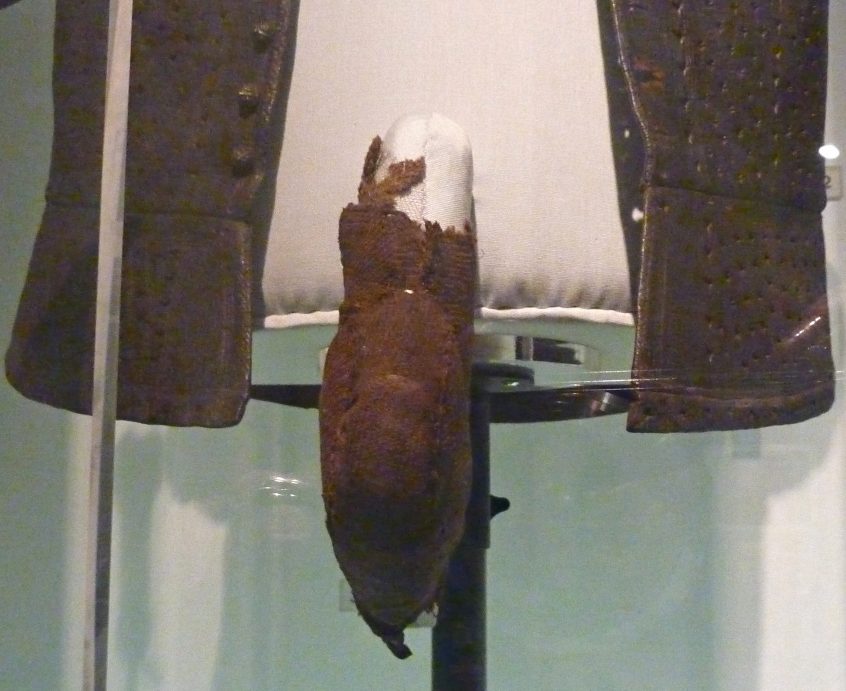Whilst writing Tudor Sex and Sexuality I especially enjoyed researching provocative fashions for this era. The Tudors had strict fashion codes, including what colours and fabrics particular sections of society could not wear. The cod-piece was a fascinating aspect of this research.
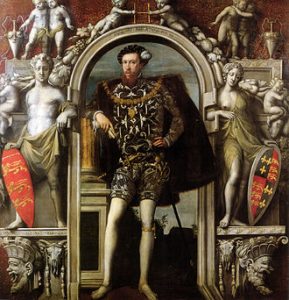
The Earl of Surrey, brooding and fashionable
Young Renaissance men appear utterly gorgeous, jewelled and colourful in paintings and manuscript work. The paintings aimed to show beauty as a signifier of inward purity and Godliness, and actually nothing to do with sex. Or did they? Because they are sexy, and doubtless they appeared so during the sixteenth century, depending on who was looking. Hose colours, for example, were significant. Green hose suggested youthful vigour whilst red hose suggested passion. Fashions shown on illustrations are often outrageous and suggestive of the exotic, foreign and mythical.
As Henry’s reign progressed, and shorter coats became fashionable, the protective codpiece men wore became even more noticeable than ever. The codpiece was originally related to the Highlander’s sporran and is related to the sportsman’s jockstrap of later times, but it undoubtedly possessed a flamboyance all of its own. The codpiece created a sense of manly display, even from under a full suit of armour.
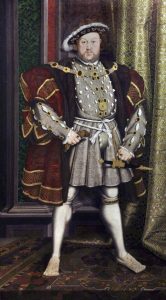
Holbein the younger, Hans; Henry VIII (1491-1547); Walker Art Gallery
The codpiece has a history. It began in the Middle Ages as a mere limp triangular flap to deal with the embarrassing absence of a covering, intended to cover that revealing gap between the two separate pieces of men’s stockings. It was also protective if created from metal and worn with armour for battle. By the sixteenth century the codpiece had developed into a statement of high fashion, therefore Tudor codpieces were individualised and accessorised and often made of luxurious decorated materials complete with ribbons and bobbles.6 Tudor men could mix and match their codpieces. A manly man could also strut around court in a garment that mimicked male genitals, drawing attention to them and exaggerating them to an absurd degree. His codpiece might be stuffed with straw to make it shapelier. Its hollow chamber had another use since it could also protect the lovely outer surface of stockings from the nasty sullying mercury-based ointment used to treat syphilis. It was also useful as a pocket. Money might be deposited within it because the wearer might need to pay an admirer. A kerchief could be tucked in the codpiece to facilitate some hasty mopping up operation. Amusingly, the codpiece sometimes served as a pincushion: men’s attire in the sixteenth century was so complicated, with many folds and wrappings around, sweepings over, tuckings, and overlappings, that pins might come in handy.7 The codpiece was daring, solid and padded. The larger the codpiece the more status was implied by its wearer.
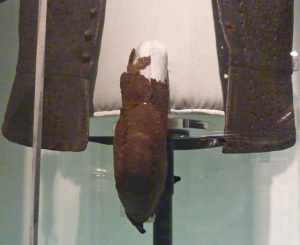
Cod Piece picture sent to me by Elizabeth Chadwick and reproduced with permission
Cod was slang for scrotum. We also have the expression ‘a man’s crown or family jewels’, referring to the pocket where coins or jewels could be stored. Just imagine reaching into the codpiece pocket for a jewel to give to a lover or mistress or even to pay a prostitute. Henry’s enormous codpiece emphasised his desired virility and capacity for providing England with heirs so he was never shy of strutting it about. It forms the centre-piece of Holbein’s drawing, The Whitehall Cartoon, which gives us Henry’s definitive image. A suit of armour belonging to Henry displayed in the Tower of London has an enormous metal codpiece. During past eras, female visitors to the Tower would stick pins in its lining hoping it would increase their own virility.
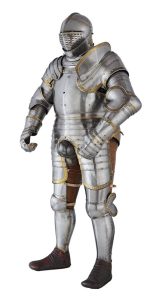
King Henry’s Armour
Holbein was extremely clever at capturing true likenesses as well as evoking richness and majesty. He flattered Henry, showing him in huge magnificence decked out in jewels, from rubies set in his collar to gems on his cap and worked into his doublet. This richness had to be displayed in portraiture because it was Henry’s identity. The Henrician court was one of the wealthiest in Europe and Henry himself was a patron of the arts. His aggressive stance in portraiture portrayed his majestic presence, legs apart, directly facing the viewer. Yet again, this was another strategy aimed to reinforce the strength of the Tudor dynasty. Layers of material broadened King Henry’s shoulders. His clothing showed a square silhouette tapering down to slimmer legs, leading the eye to the central royal importance of the procreative area, and, importantly, to Henry’s codpiece that held the potential for England’s future ruler.9 Henry’s opulence and rich surroundings, particularly when depicted as a still-young, handsome man in his forties, confirmed his wealth, power and virility. It is interesting that Henry’s armour in the Tower of London shows a man with shorter legs than in the portraits, perhaps more true to reality.
Holbein’s genius knew how to please.

To Buy Link : Amazon UK but available Amazon.com and Bookshops
Carol McGrath
Following a first degree in English and Russian Studies with History, Carol McGrath completed an MA in Creative Writing from The Seamus Heaney Centre, Queens University Belfast, followed by an MPhil in English from University of London. The Handfasted Wife, first in a trilogy about the royal women of 1066 was shortlisted for the RoNAS in 2014. The Swan-Daughter and The Betrothed Sister complete this highly acclaimed trilogy. Mistress Cromwell, a best-selling historical novel about Elizabeth Cromwell, wife of Henry VIII’s statesman, Thomas Cromwell, was republished by Headline in 2020. The Silken Rose, first in a Medieval She-Wolf Queens Trilogy, featuring Ailenor of Provence, was published in 2020 by the Headline Group. This was followed by The Damask Rose, 2021 and The Stone Rose in April 2022. Carol is writing Historical non-fiction as well as fiction. Sex and Sexuality in Tudor England was published in March 2022.
Find her on her website www.carolcmcgrath.co.uk

